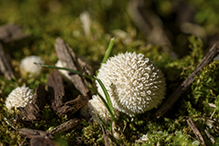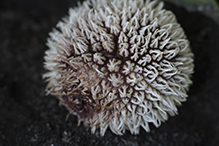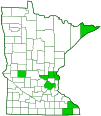Long-spined Puffball
(Lycoperdon pulcherrimum)
Conservation • Description • Habitat • Ecology • Distribution • Taxonomy
Conservation Status |
|
|||||||
| IUCN Red List | not listed |
|||||||
| NatureServe | not listed |
|||||||
| Minnesota | not listed |
|||||||
Description |
||
Long-spined Puffball is a beautiful, small to medium-sized puffball. It is found in the fall, alone or in small groups, on ground under hardwoods or on very rotten wood. It is common in the southern United States, uncommon in Minnesota. It obtains its nutrients from decaying organic matter (saprobic). The fruiting body is more or less pear-shaped, ¾″ to 19 ⁄16″ in diameter, and ¾″ to 2″ in height. It has a globe-shaped top and a sterile, stalk-like base that is usually well developed but sometimes inconspicuous. The sterile base is tapered and short, no more than half the height of the fruiting body. It is chambered and often wrinkled, white when young, turning brown to purplish-brown with age. The skin (peridium) has two distinct layers. The outer layer is white and densely covered with spines when young, dark brown to dark purplish-brown, shiny, and smooth at maturity. The spines are slender, strong, white, ⅛″ to ¼″ long. They join at the tips in groups of 2 to 6 or more creating numerous pyramid-shaped clusters (fascicles). They remain white until they are shed or wear away. When shed they do not leave marks or a network of lines on the peridium. When mature, a pore-like mouth develops at the top (apex) of the peridium through which spores are released by wind and rain. The flesh spore mass (gleba) is white and firm when young, becoming yellow and granular as it ages, and then dark purplish-brown and powdery when mature. It is edible when it is young and the flesh is firm and white. |
||
Similar Species |
||
Curtis’s Puffball (Vascellum curtisii) is smaller, no more than ¾″ in diameter. It turns light brown at maturity. It grows in grass and is usually found in tight clusters. Common Puffball (Lycoperdon perlatum) is much more common. The stalk is substantial and the top is flattened. It is covered with short white spines interspersed with white granules. The spines wear off by maturity leaving scars on the peridium. The peridium is pale brown when mature. Spiny Puffball (Lycoperdon echinatum) spines and outer layer soon turn brown, changing color together. |
||
Habitat and Hosts |
||
On the ground under hardwoods or on very rotten wood. |
||
Ecology |
||
Season |
||
Fall |
||
Distribution |
||||
|
Sources |
|||
| 9/27/2022 | ||||
Occurrence |
||||
Common in southern United States. Uncommon in Minnesota. |
||||
Taxonomy |
|||
| Kingdom | Fungi (Fungi) | ||
| Subkingdom | Dikarya | ||
| Phylum | Basidiomycota (Basidiomycete Fungi) | ||
| Subphylum | Agaricomycotina (Higher Basidiomycetes) | ||
| Class | Agaricomycetes (Mushrooms, Bracket Fungi, Puffballs, and Allies) | ||
| Subclass | Agaricomycetidae | ||
| Order | Agaricales (Common Gilled Mushrooms and Allies) | ||
| Suborder | Suborder Agaricineae | ||
| Family | Lycoperdaceae (puffballs) | ||
| Genus | Lycoperdon | ||
Order Family Genus |
|||
Synonyms |
|||
Common Names |
|||
Long-spined Puffball |
|||
Glossary
Fascicle
A small bundle or cluster, often sheathed at the base, as with pine needles.
Gleba
The inner spore-bearing mass of puffballs, earthstars, and stinkhorns. The term is also used to refer to the spore-bearing slime covering the head of a stinkhorn.
Peridium
The protective wall consisting of usually two, sometimes more layers, that encloses the spore mass of puffballs, earthstars, stinkhorns, false truffles and other gasteroid fungi.
Saprobic
A term often used for saprotrophic fungi. Referring to fungi that obtain their nutrients from decayed organic matter.
Visitor Photos |
|||||
Share your photo of this fungus. |
|||||
| This button not working for you? Simply email us at info@MinnesotaSeasons.com. Attach one or more photos and, if you like, a caption. |
|||||
Dragisoni Ferinzig |
|||||
Found a Long-spined Puffball in my backyard in Elk River MN |
|||||
 |
|||||
Homeowner |
|||||
Growing in Scott’s mulch. |
|||||
 |
|||||
Ben Heath |
|||||
 |
|||||
MinnesotaSeasons.com Photos |
|||||
|
|||||

Slideshows |
||
| Lycoperdon pulcherrimum - fungi kingdom Nineli Lishina |
||
About
Published on Jan 24, 2015 Lycoperdon pulcherrimum - fungi kingdom |
||

Visitor Videos |
|||
Share your video of this mammal. |
|||
| This button not working for you? Simply email us at info@MinnesotaSeasons.com. Attach a video, a YouTube link, or a cloud storage link. |
|||
Other Videos |
|||


Created: 10/11/2016
Last Updated:


